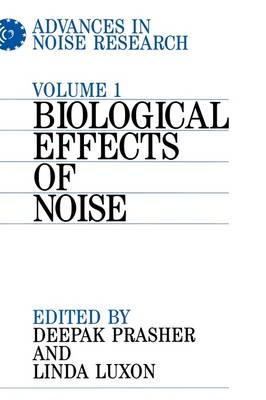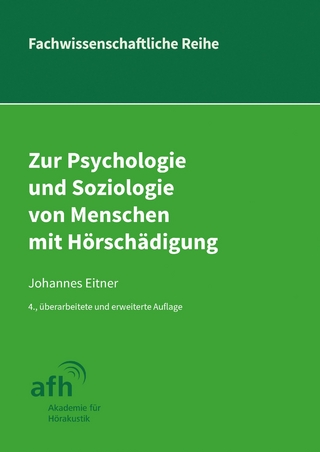
Advances in Noise Research, Volume 1
John Wiley & Sons Inc (Verlag)
978-1-86156-075-9 (ISBN)
The series entitled Advances in Noise Research has developed from the European Commission Concerted Action Programme on Protection Against Noise (PAN) The first volume in the series is devoted to the biological effects of noise and covers six main topics: physiological mechanisms, diagnosis, otoacoustic emissions, tinnitus, pharmacology and non-auditory effects in relation to noise.
Deepak Prasher, Institute of Laryngology and Otology, University College London, UK. Linda Luxon, Great Ormond St Hospital, UK.
Acknowelegements. Contributors.
Foreword.
Introduction.
PART 1: PHYSIOLOGY.
Chapter 1. Noice-induced hearing loss: current physiological investigations (Jean-Luc Puel and Remy Pujol).
Chapter 2. Spiral ganglion cell loss and survival after total hair cell destruction in the guinea-pig cochlea (Hilary C. Dodson).
Chapter 3. Evidence for functional reorganization in the central auditory system after acoustic overstimulation (Richard J. Salvi, Jian Wang and Chun Xiao Qiu).
Chapter 4. Modulating auditory sensitivity to noise trauma by sound conditioning (Barbara Canlon, Anette Fransson and Safak Dagli).
Chapter 5. The role of the acoustic reflex in the development of resistance to noise-induced hearing loss (NIHL) in humans (Vittorio Colletti and Francesco Fiorino).
Chapter 6. Pigmentation and noise-induced hearing loss: is the relationship between pigmentation and noise-induced hearing loss due to an ototoxic pheomelanin interaction or to otoprotective eumelanin effects? (Marie-Louise Barrenas).
Chapter 7. Audiometric and electrophysiological changes caused by drilling of the skull base (Vittorio Colletti, Francesco G. Fiorino, Nadia Giarbini and Zeno Policante).
PART 2: DIAGNOSIS OF NOISE-INDUCED HEARING LOSS.
Chapter 8. The clinical diagnosis of noise-induced hearing loss (Linda M. Luxon).
Chapter 9. Contralateral suppression of ABR and DPOAE and susceptibility to noise-induced hearing loss (Mariola Sliwinska-Kowalska, Wieslaw Sulkowski, Piotr Kotylo, Malgorzata Pawlaczyk-Luszcynska).
Chapter 10. How should different susceptibility factors be evaluated? (Jukka Starck).
Chapter 11. Factors influencing susceptibility to noise-induced hearing loss (Deepak Prasher).
Chapter 12. Is genetic hearing loss interactive with noise-induced hearing loss? (Risto Kaksonen, Ilmari Pyykko, Ulf Rosenhall, Jukka Stark, Esjo Toppila, Sand Kila and Juha Kere).
Chapter 13. The specific problems of noise in military life (Armand Dancer, Karl Buck, Georges Parmentier and Pascal Hamery).
Chapter 14. Ageing as a major confounding factor in noise-induced hearing loss (Ilmari Pyykko, Jukka Starck, Esko Toppila and Risto Kaksonen).
Chapter 15. Presbyacusis related to exposure to occupational noise and other ototraumatic factors(Ulf Rosenhall.
Chapter 16. A source of audiometric notches at 6 kHz (Mark E. Lutman and Hussein YN Qasem).
PART 3: OTOACOUSTIC EMISSIONS.
Chapter 17. Noise-induced cochlear changes reflected in otocoustic emissions (J. Attias, I. Bresloff, V. Furman and I. Reshef).
Chapter 18. Spontaneous otoacoustic emission modelling and noise effect on its spectral estimation (Jun Cheng.
Chapter 19. Typical findings of distortion-product otoacoustic emissions (DPOAE) in occupational noise-induced hearing loss (Jens Oeken).
Chapter 20. Measurements of distortion-product otoacoustic emisisons in industrial workers wiht noise-induced hearing loss (Sylwia Kowalska and Wieslaw Sulkowski.
PART 4: TINNITUS.
Chapter 21. Tinnitus following noise exposure: a review (Borska Josifovic Ceranic, Deepak K. Prasher and Linda M Luxon).
Chapter 22. Neurophysoiology in tinnitus (Joseph Attias and Ian Bresloff).
Chapter 23. Psychological complaint in patients suffering from chronic tinnitus (F Zenker and JJ Barajas).
PART 5: PHARMACOLOGY.
Chapter 24. The role of free radical scavengers in the prevention of noise-induced hearing loss (D Hnderson, BH Hu, XY Zheng and SL McFadden).
Chapter 25. Protective effect of the glutamate antagonist kynurenate on noise-induced hearing loss (Jean-Luc Puel, Christine C d'Aldin, Jerome Ruel and R Pujol).
Chapter 26 Prophylactic effect of magnesium in noise-induced hearing loss (Joseph Attias, Ian Bresloff, Zvi Joachims and Hartmut Ising).
Chapter 27. Hearing loss after exposure to styren and noise: a pilot study (Ann-Christin Johnson, Ing-Marie Andersson, Tomas Lindh, Per R Nylen and Eva B Svensson, Bjorn Hagerman, Thais C Morata).
Chapter 28. A review of the synergistic damage to hearing due to combined exposure to industrial noise and otoneurotoxic materials (Avi Frenkel).
PART 6: NON-AUDITORY EFFECTS.
Chapter 29. Noise-induced stress effects and accelerated ageing: its relevance for work noise-related risk increase in myocardial infarction (H Ising, W Babisch, B Kruppa and T Gunther).
Chapter 30. Epidemiological studies on cardiovascular effects of traffic noise (W Babisch).
Chapter 31. Context and coping as moderators of potential health effects in noise-exposed persons (P Lercher).
Chapter 32. Noise-induced sleep disturbance, stress reactions and health effects (C Maschke).
Index.
| Erscheint lt. Verlag | 1.6.1998 |
|---|---|
| Reihe/Serie | Advances In Noise Research (Whurr) |
| Verlagsort | New York |
| Sprache | englisch |
| Maße | 162 x 203 mm |
| Gewicht | 709 g |
| Themenwelt | Medizin / Pharmazie ► Medizinische Fachgebiete ► HNO-Heilkunde |
| ISBN-10 | 1-86156-075-3 / 1861560753 |
| ISBN-13 | 978-1-86156-075-9 / 9781861560759 |
| Zustand | Neuware |
| Haben Sie eine Frage zum Produkt? |
aus dem Bereich


